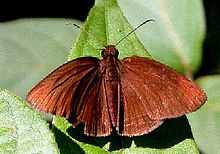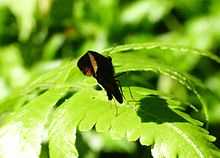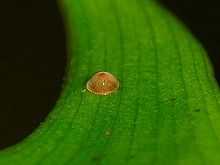Psolos fuligo
| Coon | |
|---|---|
 | |
| at Shendurney WLS, Kerala, India | |
| Scientific classification | |
| Kingdom: | Animalia |
| Phylum: | Arthropoda |
| Class: | Insecta |
| Order: | Lepidoptera |
| Family: | Hesperiidae |
| Subfamily: | Hesperiinae |
| Genus: | Psolos |
| Species: | P. fuligo |
| Binomial name | |
| Psolos fuligo (Mabille, 1876)[1] | |
| Synonyms | |
|
Sancus fuligo | |
Psolos fuligo, commonly known as the Coon, is a butterfly belonging to the family Hesperiidae. The tips of the forewing diverge outward and is a feature that is clear when they rest on vegetation.
Description
The Coon is a small butterfly with a wingspan of 36 to 46 millimetres (1.4 to 1.8 in). Both sexes look alike, excepting that the male has a prominent brand on the under fore-wing. It is a plain brown coloured butterfly on the upperside. Underneath, the butterfly is similarly coloured but paler. There are diffused greyish-purple markings on the tip of the under fore-wing and a series of pale spots in spaces 4 to 9. Similarly spots can be seen on the under hind-wing in spaces 2 to 7 and at the end cell.[2]
Distribution and status
The butterfly ranges from India to Southeast Asia and the Indonesian archipelago.
India forms the western boundary of the Coon with the butterfly found in the Western Ghats in peninsular India, and from Assam to Arunachal Pradesh, other states of the northeast India and into Bangladesh and southern Myanmar.[1][2] In southeast Asia, the Coon flies in Thailand, Malaysia, Singapore, northern and southern Vietnam, Laos, Philippines, and possibly southern China.[1] In the Indonesian archipelago, the Coon flies in Borneo, Java, Sumatra, Sipora, Bali, Palawan, Sulawesi and Banggai.[1]
The butterfly is common in India.[2]
Subspecies
There are three subspecies :[1]
- P. f. fuligo - found in Thailand, peninsular Malaysia and archipelagos of Indonesia and Philippines.
- P. f. subfasciatus (Moore, [1879]) - found in India, Myanmar, Indo-China.
- P. f. fuscula (Snellen, 1878) - Sulawesi, Banggai.
Natural history


The butterfly is a weak flier which prefers to stay low and frequent shady nooks or grassy patches in forested areas. Often seen perched on leaves. The characteristic identification of this butterfly is that the tips of the forewings of the butterfly remain spread apart even when the wings are closed.[2]
The recorded foodplants of the larva are all from family Marantaceae:
- Maranta arundinacea[3]
- Schumannianthus virgatus[3]
- Stachyphrynium spicatum (Roxb.) K.Schum.[2]
- Donax spp.[4]
The subfamily Aroidaea (family Araceae) has also been recorded as a foodplant for west Malaysia.[5][6]
References
- ↑ 1.0 1.1 1.2 1.3 1.4 Savela, Marrku. "Psolos". Lepidoptera and some other life forms. nic.funet.fi. Retrieved 21 June 2013.
- ↑ 2.0 2.1 2.2 2.3 2.4 Kehimkar, Isaac (2009). The Book of Indian Butterflies. Mumbai: Bombay Natural History Society. pp. 93–94. ISBN 9780195696202. Retrieved 21 October 2010.
- ↑ 3.0 3.1 Kalesh, S & S K Prakash (2007). "Additions to the larval host plants of butterflies of the Western Ghats, Kerala, Southern India (Rhopalocera, Lepidoptera): Part 1". Journal of the Bombay Natural History Society 104 (2): 235–238.
- ↑ Vane-Wright & de Jong, 2003, Zool. Verh. Leiden 343: 65 in Savella, M. Lepidoptera and other life forms.
- ↑ Chou Io (Ed.); Monographia Rhopalocerum Sinensium, 1-2 in Savella, M. Lepidoptera and other life forms.
- ↑ Robinson, G.S., Ackery, P.R., Kitching, I.J., Beccaloni, G.W. & Hernández, L.M. (2010). "Psolos fuligo". HOSTS - A Database of the World's Lepidopteran Hostplants (http://www.nhm.ac.uk/hosts)''. Natural History Museum, London. Retrieved 22 June 2013.